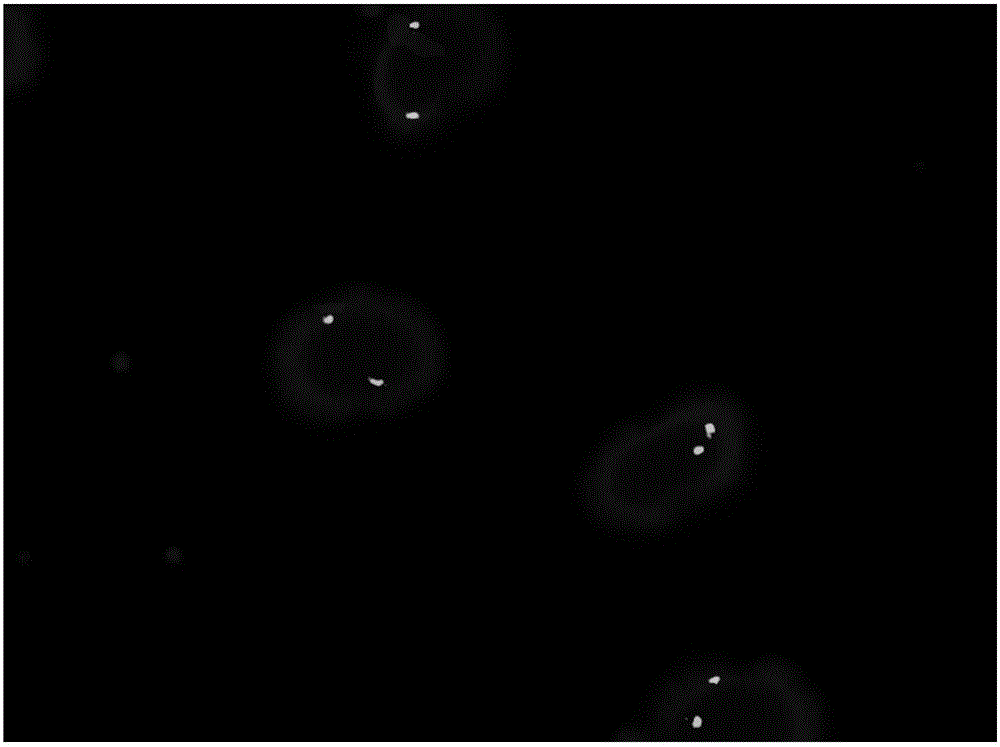Hybridization probe for detecting von hippel-lindau (VHL) gene large deletion and detection method and kit
A technology of hybridization probes and large fragments, which is applied in the fields of biochemical equipment and methods, DNA/RNA fragments, and microorganism determination/inspection. , to achieve the effect of easy promotion, easy observation and good detection effect
- Summary
- Abstract
- Description
- Claims
- Application Information
AI Technical Summary
Problems solved by technology
Method used
Image
Examples
Embodiment 1
[0059] The preparation of embodiment 1 hybridization probe
[0060] 1. Screening of hybridization probe gene sequences
[0061] The VHL gene sequences used as FISH probes were screened in the human genome, and the probe sequences with both specificity and feasibility were selected.
[0062] The VHL gene is located in the autosome 3p25-26 region and contains three exons. Retrieve all sequences containing the VHL gene in the databases of MCSCgenomebrowser, NCBICloneRegistry, and EnsemblGenomeBrowser, and screen the optimal hybridization probe sequence for the above exons, and number it as 1 Exon No. VHL-Exon1, Exon No. 2 VHL-Exon2, Exon No. 3 VHL-Exon3.
[0063] 2. Preparation of hybridization probes
[0064] 2.1 Prepare the amplification reaction template.
[0065] Collect 3ml of blood samples from healthy persons, use the blood genome DNA extraction kit (purchased from TIANGEN company, item number DP304) to extract the DNA in the blood, the operation process is carried out ...
Embodiment 2
[0108] The detection of embodiment 2 blood sample
[0109] Blood samples were detected using the hybridization probe prepared in Example 1.
[0110] 1. Preparation of cell smears
[0111] Extract 3ml of peripheral blood, treat the peripheral blood with lymphocyte separation medium, and obtain the cell layer. After the cell layer is rinsed and treated with hypotonicity, it is fixed with fixative solution, and the droplet is made into a cell smear. The specific operation steps are as follows:
[0112] 1.1 Preparation of cell suspension
[0113] Take 3ml of lymphocyte separation solution into a 15ml plastic tube, mix 3ml of peripheral blood with 1.5ml of PBS buffer, then slowly add to the lymphocyte separation solution along the wall of the plastic tube, and centrifuge at a speed of 2500r / min After 30 min, the flocculent suspended cells located in the middle part were sucked out to obtain a cell suspension.
[0114] 1.2 Treatment of cells and dripping
[0115] Place the obtai...
PUM
 Login to View More
Login to View More Abstract
Description
Claims
Application Information
 Login to View More
Login to View More - R&D
- Intellectual Property
- Life Sciences
- Materials
- Tech Scout
- Unparalleled Data Quality
- Higher Quality Content
- 60% Fewer Hallucinations
Browse by: Latest US Patents, China's latest patents, Technical Efficacy Thesaurus, Application Domain, Technology Topic, Popular Technical Reports.
© 2025 PatSnap. All rights reserved.Legal|Privacy policy|Modern Slavery Act Transparency Statement|Sitemap|About US| Contact US: help@patsnap.com



